Walking into a ballet studio, it can feel like a whole new world has opened up for you and your little dancer. Every dance studio is a little community (the dancers, parents, and teachers) and like most communities, it can feel like they have a language of their own.
When starting ballet classes there are most likely many words that will mean nothing to you, like plié or relevé, so to help decipher this dance lingo we’ve put together a glossary of essential ballet terms. You'll be up to speed on all the terms in no time and be able to chat like a pro with your little ballet dancer or their teacher!
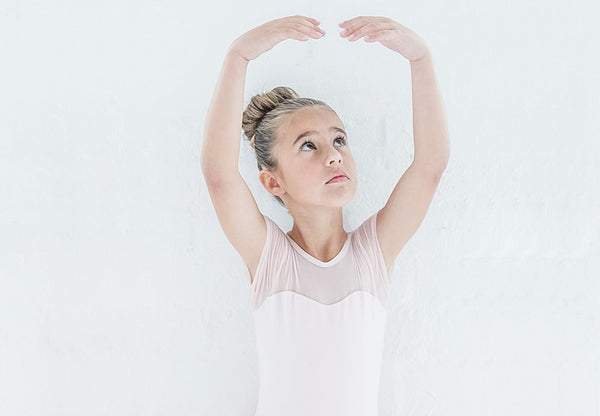
Adagio
Adagio refers to slow and graceful movements. It's helpful when used in practice as it improves a dancer's balance and strength.
Allegro
Quickly! Quickly! Allegro gets dancers moving! It is a fast, brisk style of movement. Jumping steps are classed as Allegro movements.
Arabesque
An Arabesque is when a dancer stands on one leg with the non-supporting leg raised 90º behind the body with the toes pointed and turned out so the knee faces away from the body. Both legs are extended straight.
Barre
You’ve probably heard this word before (around the gym or maybe you’ve done a ‘barre class’) and this is a term that your little dancer will become very familiar with. This is the stationary handrail support that is used in class for practicing ballet technique and for stretching, training and warm-up exercises. The barre is an essential support for dancers when practicing their ballet positions.
Chassé
Chassé translates ‘to chase’. It is a gliding step where one foot is extended in front of the other, then the rear foot moves to meet the front foot for a moment before the front foot steps forward again. The movement repeats. It looks like the back foot is chasing the front.
En pointe
Pronounced ‘on point’, is when a dancer is balancing on the very tips of their toes. Ballet dancers use pointe shoes whenever they are en pointe. Dancing en pointe is for highly skilled dancers, and it will take dancers years of practice to advance to this step.
As a little dancer, students will practice positions in demi-pointe, which is standing on the balls of their feet. Demi-pointe helps strengthen the muscles of the foot in preparation for advancing to en pointe.
The five positions
There are five basic positions that every little dancer will learn that are the building blocks of ballet.
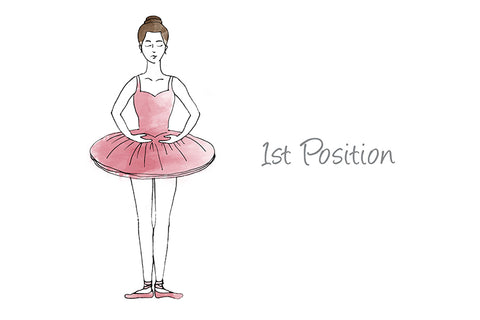
First position
Second position
This position is similar, with the feet still turned outwards, except instead of being together, feet are about hip-width distance apart. In this position, the arms are extended outwards in a straight line.
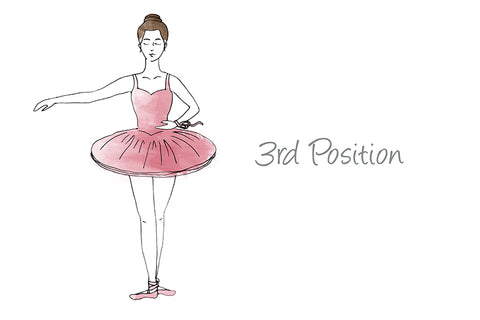
Third position
With third position, you start in first position and then move the heel of one foot to the middle of the other foot. For your arms, one arm stays in second position while the other is brought in front of you.

Fourth position
In fourth position, one foot is placed in front of the other with your feet turned out to the sides. There will be some space between your front foot and back foot. One arm stays in second position whilst the arm that is on the same side as the back leg is raised upwards.
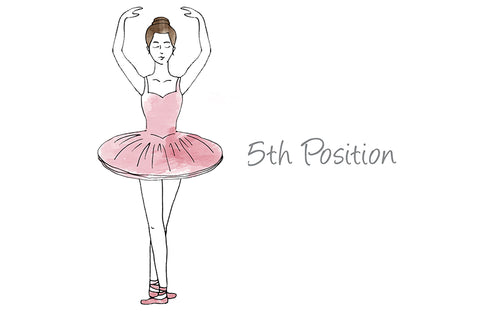
Fifth position
In fifth position, you place one foot in front of the other, as you would in fourth position, but the toe of your rear foot touches the heel of your front foot and vice versa. There is no space between your feet in fifth position and your legs are straight. Both arms are raised overhead, with a slight bend in your elbows and delicate curve of your wrist so your fingertips face each other.
Plié
You will hear this word around a ballet studio. A Plié (pronounced ‘plee-ay’) is a bit of a squat with both the knees and feet turned out. It is one of the building blocks of every ballet practice and a lot of movements begin or end with a Plié.
Pirouette
A pirouette is a complete 360º turn on one foot and one of the most fun steps in ballet! We've put together a step-by-step guide on how to pirouette here.
Pas de deux
This is a dance duet for two dancers, usually a male and female dancer. Translated from French it means a 'step for two'.
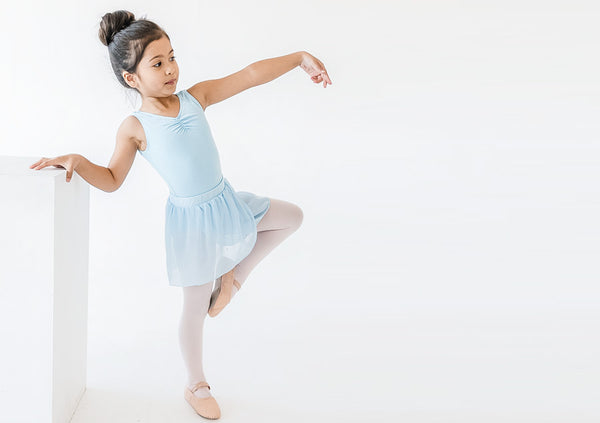
Passé
Passé is where one leg is standing straight supporting the body, while the other leg is bent at the knee into a triangle shape, and the toes of the bent leg touch the knee of the supporting leg. A little like tree pose in yoga but with the toes only touching, no sideways pressure on your supporting leg.
Penché
Penché in French means leaning, or ‘to lean.’ This is an iconic position in ballet and can be difficult to achieve. When a dancer does this, they are bent forward on one leg in arabesque positioning. The non-supporting leg must be above 90 degrees to be in this position.
Port de bras
Port de bras mean 'carriage of the arms' and can be used to describe the graceful arm movements of a ballerina or a set of exercises that improve the arms transitions from one position to another.
Relevé
Relevé, pronounced ‘ruh-leh-vay’, is when a dancer rises onto the ball of their foot or their toes. We like to think of it as relevé-ing the pressure from your heels.
Sauté
Who knew Sauté was not just a cooking word!
This word in ballet means ‘to jump’. If your little dancer is asked to do a number of these, it means to do many jumps repeatedly with both feet, landing on two feet. They might also be asked to do a 'Saute Arabesque' which would be an arabesque whilst jumping on the supporting leg.
Tendu
A Tendu begins with a dancer in one of the basic positions then stretches one leg outwards till the tip of their toe touches the floor then returns the foot to first position.
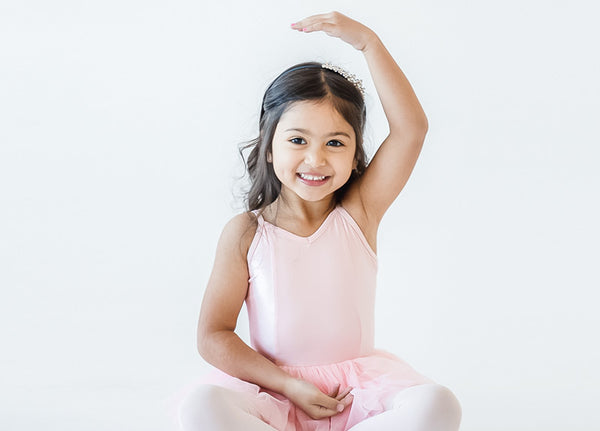
All of these terms will help you keep up with what’s going on in a dance class and with what your little dancer is chattering about. It’s good to remember that dancing should be fun and when starting classes there’s not a lot of pressure on learning a whole glossary of terms, these will come in time.
Happy dancing!
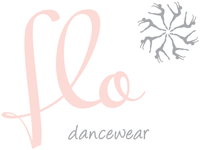

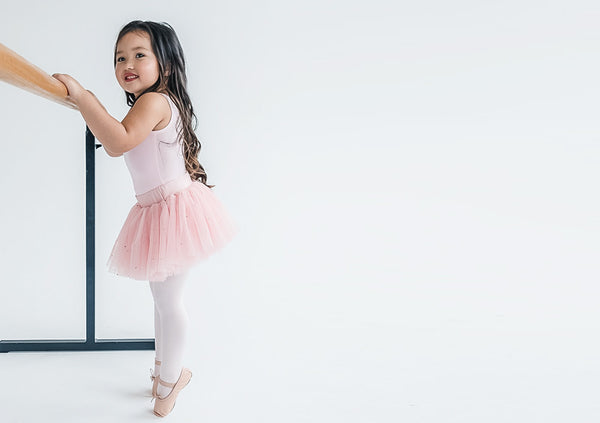
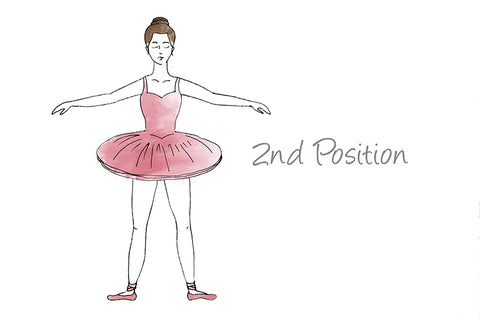
Leave a comment